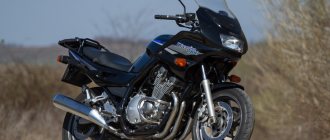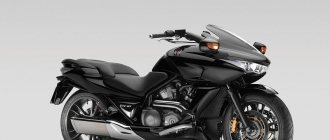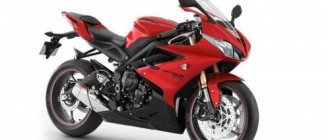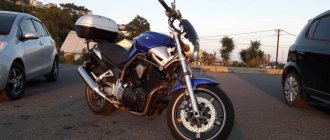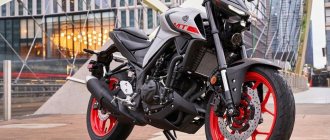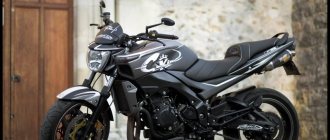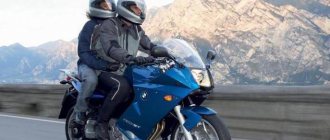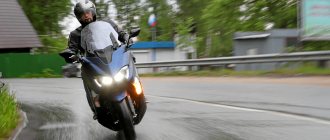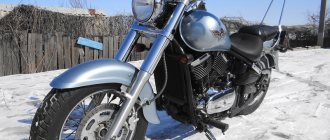The Yamaha XJ6 motorcycle is a simplified version of the famous 600 cc Phaser, and has much in common with it. And its name refers to the once famous XJ 600 model, a popular road bike , which was also highly regarded as an excellent option for touring on asphalt roads . Purely technically, the modern Diversion has nothing in common with the old XJ 600, these are completely different models, but the marketers of the Japanese company decided to play on the well-known name and were right.
49CS6334
However, despite the unremarkable engine, mediocre chassis and frankly weak brakes, Diversion was popular. Note that the motorcycle was produced for 19 years without significant changes! One of the main reasons for the consistently high demand is the very, very reasonable price for any version. All these conflicting impressions from the previous generation of “saboteurs” swarmed in my head when I took the new XJ6 Diversion for a long test - although Yamaha representatives insisted that this motorcycle was not like that at all.
Brief history of the model
2009 - start of production and sales of XJ6N and XJ6S. Model: Yamaha XJ6N + ABS; Yamaha XJ6S + ABS (Europe). Factory designation: 20S1, 20S2 + 36B1; 36C1 + 36D1.
2010 - the appearance of the “plastic” modification of the XJ6F. In the North American market it is sold as the FZ6R. Model: Yamaha XJ6N + ABS; Yamaha XJ6S + ABS; Yamaha XJ6F / FZ6R + ABS (Europe, North America). Factory designation: 20S5, 20SA + 36B2, 36B3; 36C4 + 36D2; 1CW1, 36P9, 36PC, 1CW4 + 1DG1.
2011 - no significant changes. Model: Yamaha XJ6N + ABS; Yamaha XJ6S + ABS; Yamaha XJ6F / FZ6R + ABS (Europe, North America). Factory designation: 20SB + 36B4; 36C6 + 36D3; 1CW8, 36PJ, 36PF + 1DG2.
2012 - S and N versions are temporarily not produced. Model: Yamaha XJ6F / FZ6R (Europe, North America). Factory designation: 36PR, 36PM.
2013 - no significant changes. Model: Yamaha XJ6N + ABS; Yamaha XJ6S + ABS; Yamaha XJ6F / FZ6R + ABS (Europe, North America). Factory designation: 20SF, 20SJ, 20SL, 20SM + 36B5, 36B6, 36B7, 36B8; 36CB, 36C9 + 36D5, 36D7; 1CWJ, 1CWG, 36PX, 36PU + 1DG3, 1DG4.
2014 - no significant changes. Model: Yamaha XJ6N + ABS; Yamaha XJ6S + ABS; Yamaha XJ6F / FZ6R + ABS (Europe, North America). Factory designation: 20SV, 20SU, 20ST, 20SR + 36BC, 36BB, 36BA, 36B9; 36CC, 36CE + 36DA, 36D8; 2SR3, 2SR6, 1CWN, 1CWP + 1DG5, 1DG6.
2015 - no significant changes. Model: Yamaha XJ6N + ABS; Yamaha XJ6S + ABS; Yamaha XJ6F / FZ6R + ABS (Europe, North America). Factory designation: B611, B612 + 36BD, 36BE; 36CH, 36CF + 36DB, 36DD; 1CWV, 1CWW, 2SR9 + 1DG7, 1DG8.
2016 is the last year of production for the European market. Model: Yamaha XJ6N + ABS; Yamaha XJ6S + ABS; Yamaha XJ6F / FZ6R + ABS (Europe, North America). Factory designation: B617, B618, B619, B61A + 36BJ, 36BH, 36BG, 36BF; 36CJ, 36CK, 36CL, 36CM + 36DK, 36DH, 36DG, 36DE; BS11, BS12, BS13, BS14, 2SRC + 1DGA, 1DGB, 1DGC, 1DGD.
2017 is the last year of production for the North American market. Model: Yamaha FZ6R (Diversion F) (North America). Factory designation: 2SRF.
49CS6264
A quick look at the performance characteristics only intensified the doubts: a steel frame and pendulum, simple two-piston brakes (though with ABS), a weak engine by modern standards... Was the old “Sabotage” really disguised with beautiful plastic? But, judging by the “water” cooling jacket, the new motorcycle really should be different - at least in heart.
The odometer of the new cherry Diversion shows a mind-blowing two hundred meters of mileage. This means that the first step is a 1,500 km run-in: the engine mode is no more than 2/3 of the maximum speed. The best - the most even load and temperature-friendly mode - is in long-range mode. Therefore, having loaded simple belongings into universal saddle bags, I set off from Moscow to Voronezh for the local opening of the season - a little more than a thousand kilometers there and back. From the very first hours of the trip I appreciated the decent wind protection and resistance to strong side winds. When real “sport tourists”, fully dressed in plastic, could not drive more than “hundreds” in strong gusts, “Diversion” made it possible to maintain about one hundred and forty kilometers per hour without strain (and even then the speed was limited by the running-in mode, and not by the lack of stability on the track) . Touring glass will probably add comfort, but a driver of any size can also hide from the wind behind a stock windshield (judging by myself: my height is 184 cm).
49CS6259
After arriving at my destination, I gave the ergonomics of the driver’s seat an “excellent” rating. You feel “at home” on this motorcycle: a comfortable high handlebar, a wide and soft seat, low footrests - all this makes any ride very pleasant. Despite the strong side wind that accompanied me all the way to Voronezh, I covered more than five hundred kilometers without getting tired. By the way, both a tall kid like me and a short girl can comfortably fit in a low saddle (it was not difficult to find a standard miniature biker at the festival). Well, things were good with ergonomics on the old “Diversion” as well. And I like the wind protection in the new version much better.
Flaws
- Weight . Large weight gives an advantage on the road, but not with this bike. A slight bump or pothole and he will try to jump out from under the rider. A trip to grandma’s in the village - only in dry weather and only on asphalt.
- Wind protection . It’s normal for the city, but at high speed it may not be enough for a tall motorcyclist.
- The suspension is very soft for such a colossus . With a load and number two, licking every bump on the road is guaranteed.
and dignity
- Good and strong plastic.
- Reliability.
- Unpretentiousness.
- Comfortable fit.
- Although it fits tightly, it does not require disassembly to the base for maintenance.
- The cardan does not require as frequent maintenance as a chain drive.
49CS6206
I decided to evaluate the engine and brakes upon arrival in the capital - after running in the power unit and final grinding in of the pads. The new engine impressed with its torque and elasticity. It feels like the torque characteristic has been spread evenly across the tachometer. On the highway, sixth gear can be engaged already at 85–90 km/h and even overtaking in it. After running in, I checked the “maximum speed” - the digital speedometer showed 215 km/h. However, by the end of the two-month test, when the mileage was more than five thousand kilometers, the maximum speed increased to 221 km/h. But with a passenger, the motorcycle refused to go more than 195 km/h (unlike the passenger!) - well, the aerodynamics of the vehicle (and, therefore, the “maximum speed”) are largely determined by the weight and dimensions of the crew (and cargo). So, perhaps some Japanese guy and his girlfriend will squeeze even more than my “single” maximum. But the Diversion becomes very willing to use the rear wheel.
Conclusion
While characterizing the Yamaha XJ6 Diversion F as an obedient and easy-to-ride motorcycle , let’s not forget that it has high power. Yes, it can be recommended to cautious beginners who have graduated from a motorcycle school, where they were taught not only to pass the traffic police license exam, but also to actually ride. But when riding this steel horse, you must always remember that it can easily throw off an arrogant driver who has decided that he knows everything and can do everything. But in the hands of an experienced pilot, Diversion can work wonders and serve for years without any breakdowns.
Specifications
| Maximum engine power: | 77.5 hp (57 kW) at 10000 rpm HP |
| Torque: | 59.7 Nm (6.1 kg*m) at 8000 rpm Nm |
| Working volume: | 600 cm3 |
| Motor type (cylinder arrangement, number of strokes): | 4-cylinder, 4-stroke, in-line |
| Number of cylinders: | 4 |
| Number of valves: | |
| Intake type (Injector / Carburetor): | |
| Bore and stroke: | |
| Starting system (Electric starter, kick starter): | |
| Maximum speed in km/h: | 207 km/h |
| Cooling system: | Liquid |
| Transmission (gearbox): | 6-speed, Manual |
| Clutch (Dry / Wet): | |
| Drive unit: | Chain |
| Frame: | Steel diagonal |
| Chassis | |
| Suspension (front/rear travel): | |
| Brakes (Front/Rear): | |
| Wheels / Tires / Rubber: | |
| Dimensions and weight | |
| Dimensions (Length / Width): | |
| Seat height: | |
| Ground clearance: | |
| Curb weight: | |
| Wheelbase: | 1440 mm |
| Weight: | 205 - 220, depending on modification kg |
| Fuel tank capacity: | 17.3 l. |
| Battery capacity: | |
| Year of release: | |
| Country of Origin: |
49CS6187
During the test, I was able to not only give rides to my five-foot-tall friends and petite girlfriends, but also to evaluate the passenger seat myself. It turned out that riding as number two on this motorcycle is almost more pleasant than being the driver. It is noteworthy that while I was driving, I did not experience any discomfort from the fellow passenger behind me, regardless of his height. The ergonomics of the “second number” are thought out in such a way that it absolutely does not constrain or limit the driver’s movements either on the highway or in traffic jams. The only thing that had to be adjusted in the motorcycle was “clamping” the spring of the rear shock absorber. Fortunately, this is convenient to do, and a special key is present in the included tool kit.
49CS6193
The bike performed even better in the city than outside of it. Short passes, which I so wanted to “stretch” on the track, come in handy here. The device demonstrates very good dynamics, and the small width of the fairings and the huge steering angle make the process of piercing plugs almost the most enjoyable experience in the world. “Sabotage” made it possible, without even straining, to stay behind the motards in city traffic. True, only when they were moving along the roadway. The work of the suspensions caused only positive emotions. Even in the absence of adjustments (except for the spring preload of the rear shock absorber), they work out large irregularities well, and you hardly notice small ones at all (note: I weigh a hundredweight in the equipment!).
49CS6222
“Diversion” was also a pleasant surprise on the karting track, showing very good handling. Much of this is due to the narrow rear tire and low center of gravity. If we compare it with the Fazer, then with the same base and despite the fact that the FZ6 has a one-degree lower fork angle, the XJ6 steers much better. True, what is good for comfortable movement is not always useful on the track. The footpegs, the “anchors” of which are enough for at most five sessions, are located so low that they do not allow the use of the entire working surface of the tire. However, in everyday life they practically do not restrict maneuvers. By the way, if you often go to the track, be prepared for the fact that after the “anchors” the side stand will be rubbed off on the asphalt. But the central one, oddly enough, never touched the road surface.
Let's sum it up
“The XJ6 offers the rider a more comfortable riding position. Unfortunately, Yamaha engineers did not provide a single niche in the wide fairing where small luggage can be placed.”
Diversion is ready to become a reliable ally for daily trips along the “home-to-work” route, often strewn with a number of “traps” in the form of flaws in the road surface. Comfort will be guaranteed under any conditions, including for riders who live outside the city and are forced to cover several tens of kilometers every day.
Kawasaki is the ideal choice for those who value a sportier look and character. However, for the sake of these qualities you will have to sacrifice comfort.
49CS6217
I will also note the performance of the brake system. The simple two-piston brakes behave very well. Without trying to set a lap record, they deserve a solid four. There is no excessive tenacity, as on sport bikes, when the slightest touch of the lever “with a stake” stops the motorcycle, but the deceleration remains at a high level. For normal city driving, it’s just what the doctor ordered. By the way, blocking of the rear wheel is also easily predictable here. In addition, the already decent brakes were supplemented with an anti-lock braking system, which, in my opinion, is “on point” on this class of motorcycles. The system operates predictably and smoothly, with slight feedback to the brake lever or rear brake foot. If you suddenly decide that the new XJ6 will be your first motorcycle, I strongly recommend taking the version with ABS - this will allow you to feel the moment the wheels lock without unpleasant consequences.
Overview of modifications
The XJ6 Diversion model became a kind of continuation of the more powerful Yamaha FZ6 and replaced it in the European markets. In America it is sold under the name FZ6R.
It was produced almost from the very beginning in three versions: a basic one with a front fairing, without a front fairing with the index N in the model designation, and in a sports version, designated by the letter F.
The model in all variants was restyled in 2013.
The side panels have been redesigned, and changes have been made to the headlight fairing, passenger handles and LED instrument panel lighting. Yellow color has been removed from the color options; the basic version can be equipped with an ABS anti-lock braking system as an additional option. The saddle received a new leather trim, and the turn signals received new lenses. The chain tension system position indicator appears.
At the same time, Yamaha released a limited edition XJ 6 SP Dark Menace. It differs only in the spectacular carbon fiber finish, combined and six on the fairings.
49CS6225
The operation of the gearbox does not cause any complaints, there were no false neutrals, the gears were engaged easily and clearly. True, not yet in the Honda way, but no longer in the old Yamaha way, when you had to apply noticeable effort to the paw. The only thing I, as a travel enthusiast, would change would be to “stretch” the two top gears. In the city you still don’t have to go higher than fourth, but on the highway fuel consumption will decrease.
The motorcycle proved to be very economical. A 17-liter tank in city mode (with dynamic acceleration from traffic lights) is enough for three hundred kilometers. In long-distance driving, if you don’t go over two hundred, you can go three hundred and fifty kilometers at one gas station.
Driving characteristics, fuel consumption
The maximum speed announced by the manufacturer was 203 km/h . But users argued that the 240 km/h on the speedometer is quite achievable if there is high wind protection.
Acceleration to hundreds
Acceleration from zero to 100 km/h was 4-4.5 seconds .
Fuel consumption
Fuel consumption according to the designers is 5.75 liters. per 100 km . According to user tests - 6 liters per 100 km at an average cruising speed of 120 km/h .
49CS6385
Although the instrumentation is simple, all readings are perfectly readable. And even the bright sun does not interfere with seeing the indicator lamps. In addition to engine temperature, fuel level and odometer indicators, the LCD display also includes a reserve mileage indicator, which turns on as soon as three and a half liters of fuel remain in the tank. On top of that, now the tidy is also a diagnostic center, where you can display many readings of various engine parameters (we talked about something similar in Moto, No. ??-2009 using the example of the Yamaha TDM900). And all this without any jumpers - using the ignition key and buttons on the dashboard.
A beautiful “crystal” headlight with a “star in its forehead” shines as well as it looks. The main thing is not to forget to adjust the beam of light for driving alone or together - fortunately, getting to the right screw is not difficult. You can hardly see your shoulders in the mirrors, but the road conditions behind you are visible almost as well as in front. The only negative is that the mirrors fold at a small angle both backwards and forwards. In the city it’s enough, but on the track you start to worry about the glass.
49CS6209
In the end, it turns out that the Yamaha people were right when they said that the new “Diversion” is not at all similar to the previous one. This is an incredibly beautiful and fast bike that handles, rides and brakes well. Diversion will be a good help in mastering the world of motorcycles; I won’t be afraid to recommend it to beginners. The only thing that the new generation has in common with the one that was recently discontinued is a very “tasty” price, which is very useful in today’s difficult times.
The motorcycle for testing was provided by Yamaha Motor CIS.
Front fork
General information:
- The diameter of the fork leg is 41 mm.
; - The oil used is Suspension oil 01 Yamaha with a viscosity of 5w
in each leg of
473 cm3
(about one liter of oil is needed to repair the entire fork); - Fork seal size: 41x53x11 mm.
; - Fork spring length: 365.1 mm
.
Original spare parts:
- Oil seal, one per package: 5VU-23145-00-00
(Normal price - $11). - Boot, one per package: 3VD-23144-00-00
(Normal price - $15). - Upper fork guide: 3VD-23125-10-00
(Normal price - $14) - Lower fork guide: 3VD-23135-10-00
(Normal price - $11)
Analogues from All Balls Racing:
- All Balls 56-156
boot and seal kit (two boots, two seals in the box) - $28 - Oil seals only (2 pieces per box) All Balls 55-116
- $14 - Anthers only (2 pieces per box) All Balls 57-143
— $15
